As the Neocatechumenal Way becomes more established in your parish, many of you are undoubtedly very eager to expedite the adoption of Kiko Arguello’s New Aesthetic into your parish’s church building. Let me suggest some steps you should take to accomplish this.
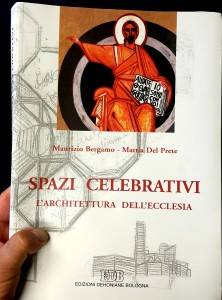 First, as quickly as you can, get yourself a copy of “Spazi Celebrativi, L’Architettura dell’Ecclesia” (Celebratory Spaces, the Architecture of the Church) by Maurizio Bergamo and Mattia Del Prete, Kiko Arguello’s chief architects. The book is a goldmine of information about Kiko’s New Aesthetic, and will certainly prove useful in hastening the makeover of your parish church and liturgies. The book is written in Italian, but don’t worry, there are lots of great pictures and I’ll be giving you a head start by discussing two of the authors’ important points in a minute.
First, as quickly as you can, get yourself a copy of “Spazi Celebrativi, L’Architettura dell’Ecclesia” (Celebratory Spaces, the Architecture of the Church) by Maurizio Bergamo and Mattia Del Prete, Kiko Arguello’s chief architects. The book is a goldmine of information about Kiko’s New Aesthetic, and will certainly prove useful in hastening the makeover of your parish church and liturgies. The book is written in Italian, but don’t worry, there are lots of great pictures and I’ll be giving you a head start by discussing two of the authors’ important points in a minute.
After thoroughly acquainting yourself with the plans in the book, do everything you can to start a working relationship with
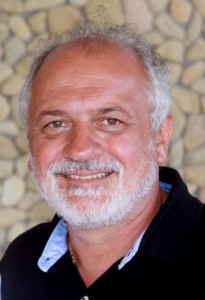
Mattia Del Prete or a member of his approved team of architects. The sooner, the better, and use the book to help you. You see, to conform fully to Kiko’s New Aesthetic, your church building and parish will have to be completely renovated, and only architects approved by Kiko can be hired for this. Mr. Del Prete was given approximately $80,000 by Catholics from Guam for the design of the “Sanctuary of the Word” at the Redemptoris Mater Seminary in Guam. Luckily for Mr. Del Prete, he did not have to actually design a new chapel with this  money, because it was decided that he would provide the plans from a chapel he already had designed in Macerata, Italy. The “Sanctuary of the Word” chapel on Guam was never built, but that’s beside the point, because you too will have to send them money – tens of thousands of dollars – for design and engineering plans. After you get the plans, you’ll then have to take them to an architect licensed to practice in your state, territory, or province to get them converted to English measurements and to include locally available materials and fixtures. So, up and at’em and get started!
money, because it was decided that he would provide the plans from a chapel he already had designed in Macerata, Italy. The “Sanctuary of the Word” chapel on Guam was never built, but that’s beside the point, because you too will have to send them money – tens of thousands of dollars – for design and engineering plans. After you get the plans, you’ll then have to take them to an architect licensed to practice in your state, territory, or province to get them converted to English measurements and to include locally available materials and fixtures. So, up and at’em and get started!
Now let’s take a brief tour of the book, along with pictures taken from it. Get out your pen and take notes, because I’ll be giving you some tips on how to put the advice of Mr. Bergamo and Mr. Del Prete into practice.
In a chapter called, “Critical Issues and Perspectives Opened by the Council”, the authors present five liturgical problems they say were addressed by the Second Vatican Council. Of these problems, the authors say,
“We wish to emphasize aspects that are often regressive and whose presence still prevents the realization of a real reform of the liturgy and then of designing an effectively renewed Church space.”
Since the authors have clearly said that the presence of these things still prevents liturgical renewal, let’s get you started on ridding your parish of two of them.
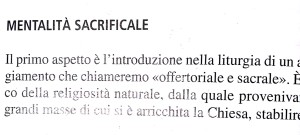 The authors name the first bad aspect, “sacrificial mentality”. The authors say,
The authors name the first bad aspect, “sacrificial mentality”. The authors say,
“It is typical of natural religiosity, from which came the great masses which expanded the Church, establishing with God a relationship in which you offer things to appease him and to obtain benefits: sacrifices, lambs, money, in some cases, human life itself. Israel also for a time had this kind of sacrificial worship…It remains today...The architectural consequences are considerable: first in the way of an emphasis sacredness of the rite, and then the environment, through the grandeur and wealth of architecture, mosaics, candles and lamps, incense, music. This will also be the meaning of the gloom of the medieval halls, the upward Gothic forms, the phantasmagoria of the windows…The mysterious appearance is accentuated and the place of the liturgy is separated by creating a sacred area inside the same church, which only one category of persons may access, separate from the people involved, as mediators between the sacred and the profane: the clergy, the priests, as in rites of natural religiosity. even the altar,,,assumes more and more the shape of sacrificial altar: a block of marble, small in size, highly decorated on the side faces, placed in a very high position, over several steps, often contained in a second little temple consisting of the tabernacle that was sometimes closed further with curtains.”
It’s clear what you now have to do! Eliminate the sacrificial from your Mass!
Oh, I know that you were taught that Jesus was the Lamb of God, the sacrifice of the New Passover, and that in the Mass Jesus’s sacrifice on Calvary is made present. Yes, there are plenty of scripture verses to support this. But get with the program! The sooner you forget that stuff and agree with Del Prete and Bergamo that the Church went to hell in a hand basket after the Emperor Constantine because of all those unwashed pagans, the better! So here are my tips to make it easier for you to get rid of the “sacrificial mentality” of your parish:
- Change your “altar” to a mere table
- Convince your pastor to minimize the sacrificial language of the liturgy by always using Eucharistic Prayer #2.
- Get rid of the notion of a “sacred” sanctuary that only serves to exclude the faithful. One good way to do this is to have the parishioners do a lively dance immediately after Mass. Bring them up into the sanctuary and dance around the
altarEucharistic table. - Convince your pastor to do away with offertory processions, if at all possible. These epitomize the concept of “sacrificial mentality”!
- As much as possible, call your priests by their first names and teach your children to do so too
- Reduce the use of incense and those silly candles. Put flowers on the
altarEucharistic table instead - And finally, get that tabernacle out, or at least moved from front and center! And if you really can’t do that, consider getting one of the double-decker tabernacles shown below.
A second problem brought to our attention by the Second Vatican Council, according to the authors, is that of “private devotions”. The authors say, 
“The nineteenth century marks in the history of the Western liturgy, one of the moments of maximum impoverishment: participation by the people is long gone, replaced by a passive “to hear mass”, not only with the complete clericalization of worship, but also with the transformation of the dynamics of the rites in a series of private devotions to the most varied particular objects of worship….The adoration of Christ present in the Tabernacle, devotion to his heart and his passion, as well as the cult of Mary and the saints in its most varied forms said so much to the faithful that little or nothing is understood of the liturgical expressions;”
Here are my tips:
- Get rid of those statues, slowly but surely! One Neocatechumenal pastor on Guam had the great idea of putting all of his parish’s statues in the center aisle of the church one night, facing the door as if they were about to leave. This greatly endeared the pastor to his people, so I highly recommend that you too try a strategy like this.
- Get rid of the kneelers. You won’t see any kneelers in Del Prete’s book, and there shouldn’t be any in your parish church either. Del Prete says this is what the Fathers of the Second Vatican Council wanted, so get with the program. This will have the added benefit of stamping out any unruly signs of prayerful contemplation that might arise.
- And speaking of contemplation, try not to leave any time for silence before, after, or during your Masses. Private devotions often fill those voids, and as we said, they must be avoided.
I hope that this book and these tips get you started well on your way to implementing the prophet Kiko’s New Aesthetic in your parish church.
Get your parish Kiko-fied!
Examples of “catecumeniums” from the book. One chapel built for each community within the parish so that they can celebrate Mass separately, but simultaneously. Sure to enhance parish unity!
Transparent chairs, and even a transparent altar Eucharistic table! This sure wasn’t designed by unwashed pagans. Pure heaven!
Double-decker Tabernacles, for both the Blessed Sacrament and the Book of Gospels. A sure way to undermine that Eucharistic adoration that itself undermines true renewal!
And last, but not least, a Spaceship/Flying Saucer church. Take me to heaven!

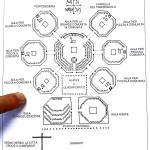
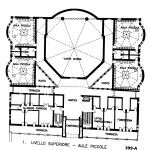
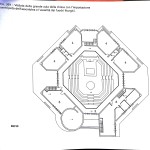
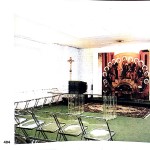
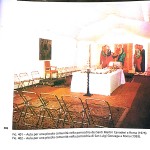
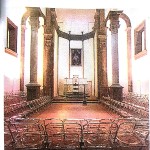
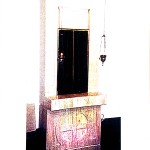
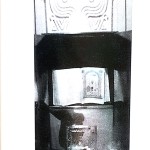
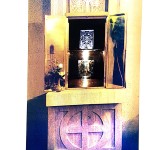
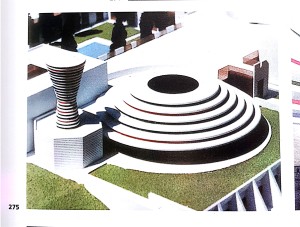
Great!
On Spaceship Church Kiko’s Flystones, look at this web….Jedis of Galilee
Very good your post, very acute your tips.
Note the double decker Tabernacles show exactly the philojudaism of the Neocatechumenal Way, as they include not the Gospel, but the Bible of Jerusalem edition in pure silver cover.
When a community ends the Way, it is a must…the Bible in silver cover as a part of liturgical trousseau.
Maybe you have seen before some video of a neo-eucharist, priest get into the assembly preceded by one who has a humeral cloth and carry the silvered Bible in procession, he can not handle it with his nude hands, he must has the humeral between his hands and the Bible, like jewish.
Also note the double decker Tabernacle is set in a long surface of marble, shaped in just one piece.
Look at “Yeshiva” in Domus Galilaeae, for example, it’s a room to scrutinize the Bible. All Redemptoris Mater Semminars have one. “Yeshiva” are a replica of jewish rooms in their rabinic schools.
All desk are lined in perpendicular to the Tabernacle marble wall and people sit ones facing each others, like in a assembly. Also they pray Liturgy of the Hours in the Yeshiva, the lector is situated in a kind of pulpit on jewish style close to the marble wall of the Tabernacle.
Kiko says the marble wall is the Veil of the Temple, the real image of your sins. You can not pass through marble surface, you need Jesuschrist to break it. The Veil of the Temple of Jerusalem was teared just in the moment when Christ expired.
The only way to pass through your sin is with the Body of Christ and, of course for Kiko through the Word of God in the Bible too. It is quite important that idea: the Bible is as alive as the Body of Christ in eucharist. And when you are in the Way, you are firmly convinced of that…The salvation comes through your ears when listening the Word as much as when you receive the sacred Body of Christ and the sacred Blood.
I mean in the Way you are trained to value the Word as a sacrament or quite near.
Kiko and catechist tell us it is a very grave sin when a Bible falls down to the floor. Only if you see that, you have to fast as penitence. You have to take your Bible in a velvet case or similar protection (neo-designed, of course). It is sacred. It is God…his living word.
Well, if you visit Domus Galilaeae or look at the pictures in internet, you can see the right place over the Yeshiva (the Word room), just in the right line over the double decker Tabernacle, is located the great Tabernacle which contains a genuine Torá, pure jewish.
And finally, over the Torá Tabernacle is the kind of twisted cornet you can see on your last picture, left hand. It has coloured lines which shine in the dark of the night as a carnival or something worst. This cornet represents the Holy Spirit.
Sorry but this neo aesthetic reminds me the coloured cap of Bob Marley….and maybe marijuana on the Barracks!
yikes. if this wasn’t such a serious matter, i’d be laughing even harder. translucent?
You’re right. I meant “transparent”. Thanks, Rey!
i was just amazed that there was such a thing as translucent or transparent chairs. i don’t think i’ve ever seen either of those before. 🙂
if they brought those on guam, they better be stainless steel as well, or aluminum, or else they’ll get rusty very quickly. haha.
Transparent chairs and tables are available in IKEA stores.
Did you forget about the menorah on every altar? Since when was that a Chritian symbol? Or when has the Church approved of appropriating Jewish symbols? Kiko’s sect is a combination of neoluthernanism and jewish elements.